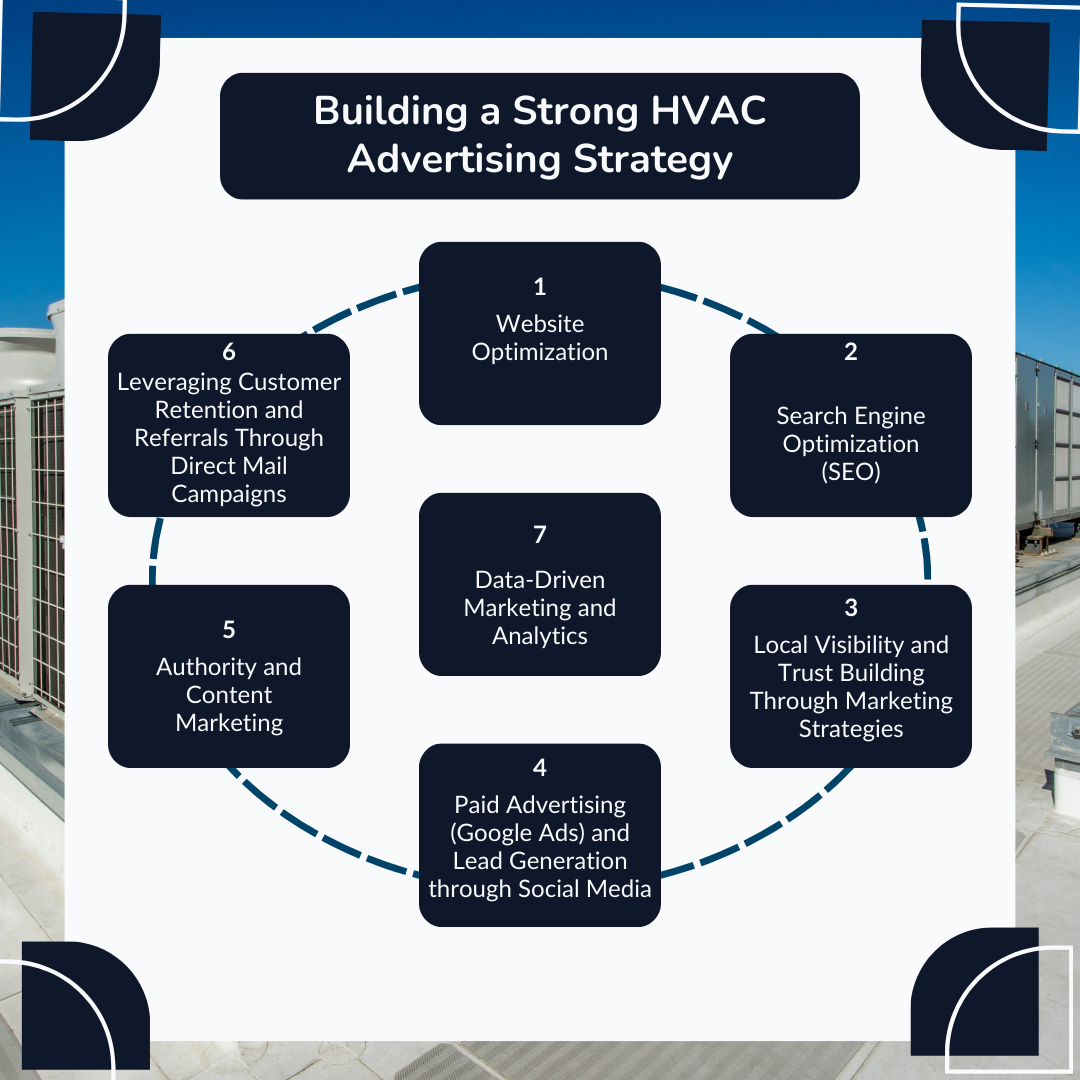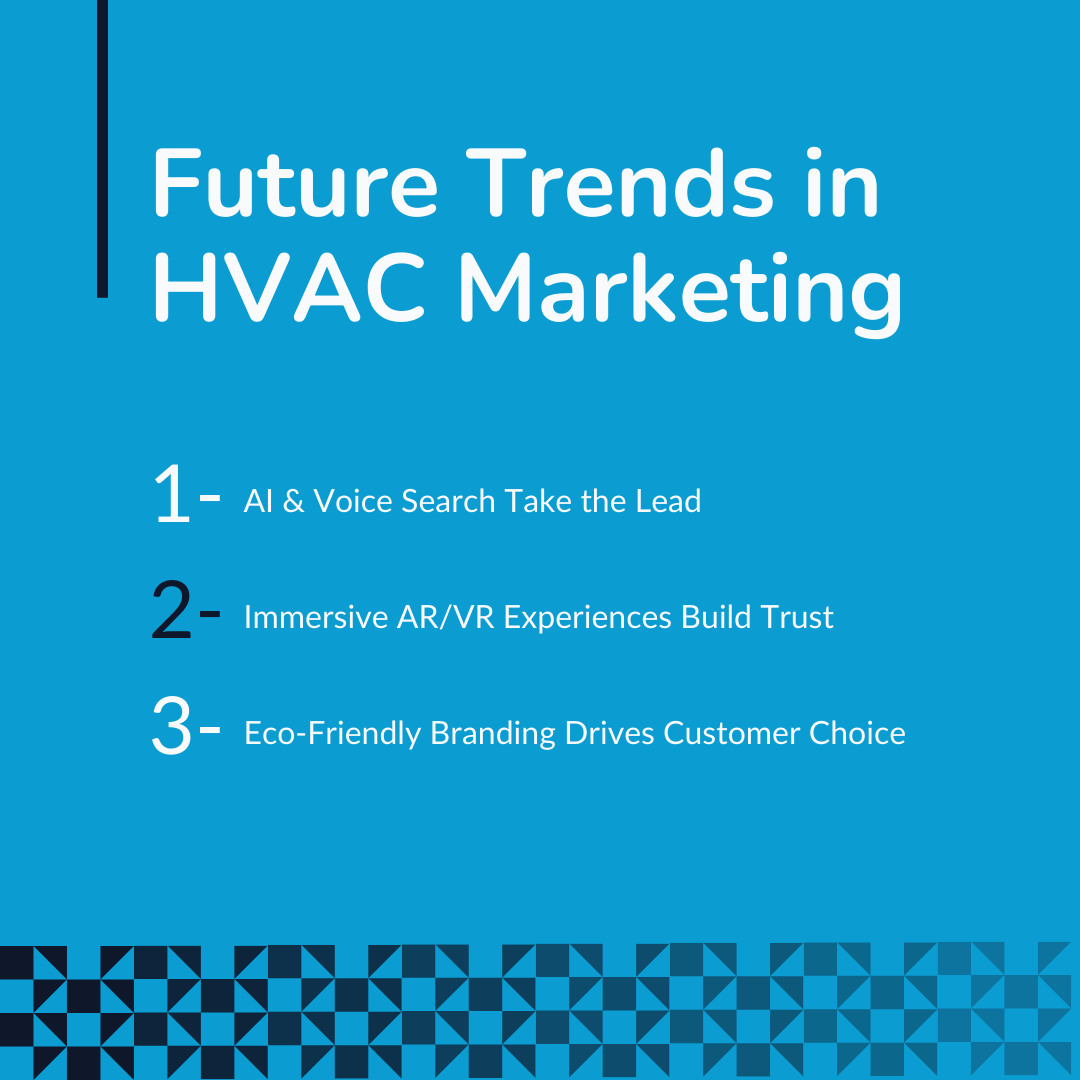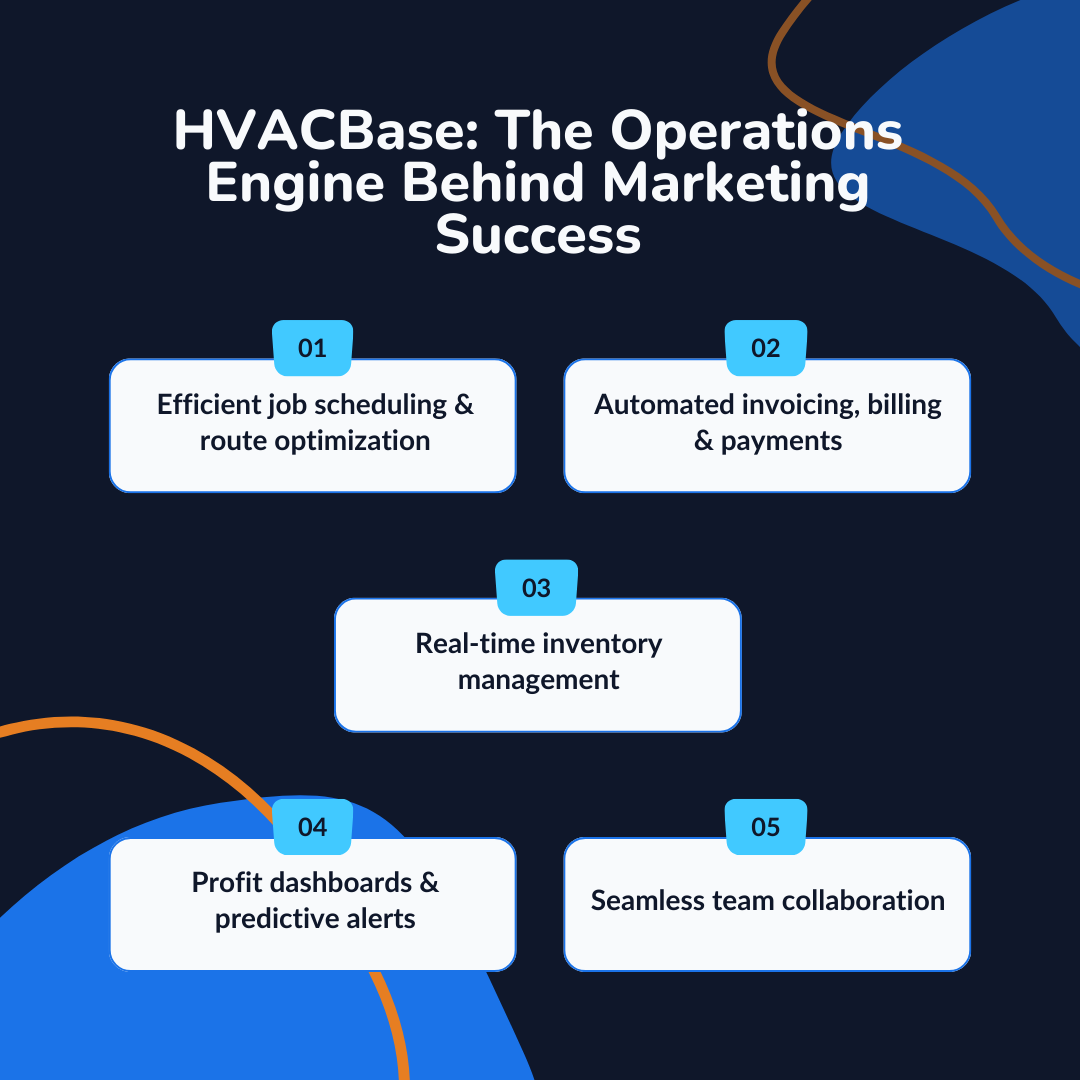HVAC Marketing and SEO: Finding Local Commercial/Residential Leads
The HVAC industry is no longer just about fixing air conditioners or installing heating systems; it’s about being found by the right customers at the right time.
For HVAC business owners and contractors, mastering digital marketing isn’t optional anymore; it’s survival.
From search engine optimization (SEO) that gets your HVAC website ranking for “HVAC repair near me” to local ads that put your services in front of nearby homeowners and businesses, the right marketing strategies can transform casual browsers into loyal HVAC clients.
At HVACBase, we know the difference between an HVAC company that struggles for visibility and one that thrives comes down to smart, practical, and localized HVAC marketing.
HVAC Marketing & Local SEO Tips to Attract More Commercial and Residential Leads
In today’s competitive HVAC industry, simply offering great HVAC services isn’t enough; visibility drives growth.
HVAC companies can reach more homeowners needing furnace repairs and attract commercial clients for long-term contracts with the help of strong digital marketing and local SEO.
From optimizing your Google Business Profile to running PPC ads and leveraging customer testimonials, these HVAC marketing strategies help local HVAC companies attract potential customers, boost HVAC sales, and convert online searches into loyal clients.
Key Takeaways
- SEO is no longer optional; 97% of your HVAC leads begin with an online search. Optimized websites, Google Business Profiles, and local SEO are critical for visibility.
- Strong local visibility builds trust, and trust drives long-term HVAC clients.
- Fast, professional proposals and PPC campaigns capture seasonal and urgent demand before competitors do.
- Smart digital marketing fuels growth, but backend efficiency sustains it.
- With HVACBase, every lead turns into profit through streamlined operations.
Why HVAC Businesses Can’t Ignore SEO and Marketing
The Changing Landscape of HVAC Marketing

The HVAC industry is changing faster than ever. Homeowners and facility managers no longer flip through phone books to find HVAC services; they rely on search engines, Google Maps, and online reviews.
In fact, 97% of people go online to find a local business, which means your next big commercial contract or residential lead probably starts with a Google search.
For any HVAC business, this means HVAC SEO, local SEO, and smart digital marketing are no longer optional; they’re critical to survival.
A strong HVAC website, optimized Google Business Profile, and creative HVAC marketing campaigns ensure you stand out against local HVAC companies and national franchises.
Here’s why every HVAC company should treat marketing as a priority:
- Digital-first discovery: Potential customers search online for HVAC systems, air conditioning, and furnace repair.
- Sustainability focus: Eco-friendly HVAC marketing ideas appeal to today’s environmentally conscious HVAC clients.
- Informed buyers: Prospective customers research HVAC contractors, check customer testimonials, and compare options before deciding.
- Tough competition: The best HVAC companies invest in HVAC advertising, PPC ads, and social media campaigns to capture HVAC leads first.
By embracing HVAC digital marketing strategies, from content marketing to email campaigns, HVAC business owners can drive sales, build brand awareness, and win trust in their local community.
Also, explore What is HVAC CRM Software and How Can It Grow Your Business?
Building a Strong HVAC Advertising Strategy

1. Website Optimization
When it comes to HVAC marketing, your website is often the first impression potential customers have of your HVAC company. This is why website optimization goes beyond search engine optimization; it’s about creating a smooth, professional experience for visitors.
A strong HVAC website should load quickly, work seamlessly on mobile devices, and feature clear service pages for installation, repair, and maintenance. Easy navigation ensures HVAC clients can find what they need without hassle.
Adding strong calls-to-action, like “Schedule Now” or “Request a Quote,” helps convert visitors into leads.
For HVAC business owners, investing in website optimization is one of the smartest HVAC marketing strategies. It builds trust, improves user experience, and positions you as one of the best HVAC companies in your local community.
2. Search Engine Optimization (SEO)
Search Engine Optimization (SEO) is a game-changer for any HVAC business looking to attract more potential customers.
By using local SEO strategies like targeting service-based keywords such as “furnace repair” or “air conditioning installation in [city]”, HVAC contractors can capture prospective customers right when they’re searching for help.
Optimized listings on Google Maps, paired with authentic customer testimonials and positive online reviews, build trust and credibility.
Strong content marketing, including educational blogs about common HVAC issues, positions your company as one of the best HVAC companies in the local community. Incorporating ppc ads and smart HVAC SEO ensures your HVAC leads increase while enhancing brand awareness.
Whether serving residential or commercial HVAC, optimized pages for mobile devices, blogs, and calls-to-action can directly drive HVAC sales.
Simply put: better SEO means more visibility, more trust, and more booked jobs.
3. Local Visibility and Trust Building Through Marketing Strategies
Local Visibility and Trust Building is one of the strongest pillars for growing an HVAC business. When people search for heating or cooling services, they don’t just want speed; they want someone they can trust in their own local community.
By improving your digital footprint and credibility, you can position yourself among the best HVAC companies that customers feel confident calling.
Here’s how to make it happen:
1. Google Business Profile Optimization
Keep your profile updated with accurate service details, working hours, and location. This helps you show up in local SEO searches and Google Maps, attracting more prospective customers.
2. Online Reviews Management
This encourages satisfied clients to leave positive customer testimonials across Google, Yelp, and niche industry platforms. Responding professionally to reviews, good or bad, strengthens brand awareness and credibility.
3. Certifications & Licenses
Displaying your certifications, licenses, and affiliations proves you’re a qualified, trustworthy choice for both residential and commercial HVAC services.
Helping out a customer who posted a negative review by replying back and assisting them with their issues can also improve your brand management, instead of simply saying "Thank You" to all the positive reviews.
4. Local Partnerships
Collaborating with builders, property managers, and contractors not only drives HVAC leads but also builds long-term referral networks that boost HVAC sales.
When customers see an HVAC contractor with strong visibility, verified expertise, and glowing reviews, they don’t hesitate; they call.
4. Paid Advertising (Google Ads) and Lead Generation through Social Media
Paid Advertising and Lead Generation are where HVAC companies can quickly stand out in a competitive market.
Unlike SEO, which builds momentum over time, paid ads give you immediate visibility with homeowners actively searching for help.
Google Ads are especially powerful since they operate on a pay-per-click model, meaning you only pay when a customer actually clicks on your ad.
Seasonal campaigns on Google Search, for example, “AC repair near me” in summer or “furnace installation” in winter, help capture urgent demand.
Social media ads add another layer by targeting homeowners based on location, age, and property type, ensuring your message reaches the right audience. Pair this with a CRM system to track every lead, and you create a streamlined funnel from click to closed deal.
Social media, too, can be organic or paid. Boosting posts, reels, or stories on social media is a form of paid advertising with the tag "Ad" or "Sponsored" attached to the piece of content. Creating high-quality content tied to the trends on the Internet can help improve reach.
Here’s how paid ads fuel growth:
- Pay only for quality HVAC leads.
- Reach customers in seasonal peaks.
- Track ROI through CRM integration.
Check out The Complete Guide to HVAC Project Management Software for 2025
5. Authority and Content Marketing
For HVAC business owners, building trust with potential customers often starts before they pick up the phone. A strong content marketing strategy can showcase your expertise and position your company as one of the best HVAC companies in your local community.
Hosting webinars or Q&A sessions on HVAC systems and energy efficiency builds brand awareness while engaging prospective customers.
Customer testimonials, online reviews, and success stories add credibility, while publishing insights on social media platforms or LinkedIn helps HVAC digital marketing campaigns reach the right target audience.
Combine this with local SEO, Google Business Profile optimization, and smart HVAC SEO practices to rank in Google search results and other search engines, driving quality HVAC leads to your HVAC website.
6. Leveraging Customer Retention and Referrals Through Direct Mail Campaigns
Leveraging customer retention and referrals is key to scaling an HVAC business plan. Membership programs offering discounted furnace repair and air conditioning maintenance help build long-term trust.
Automated reminders keep HVAC customers on schedule, while referral rewards encourage them to recommend your services within the local community.
Here are some referral reward ideas that work well for HVAC businesses:
- Discounts on services – e.g., $50 off the next air conditioning or furnace repair when a new customer signs up.
- Free maintenance – a complimentary seasonal tune-up or filter replacement for every successful referral.
- Gift cards – popular retail or fuel gift cards (Amazon, Home Depot, local stores).
- Service credits – $100 credit applied to the customer’s HVAC account for future use.
- Priority scheduling – referred customers get VIP booking slots during peak seasons.
- Tiered rewards – refer 3 friends and earn a free year of maintenance membership.
Combine this with an email marketing strategy and occasional email marketing campaign sharing seasonal tips and promotions. The most common email automation tools are HubSpot and MailChimp.
When paired with social media platforms, HVAC SEO, PPC ads, and strong online reviews, these marketing efforts enhance brand awareness and position you among the best HVAC companies.
7. Data-Driven Marketing and Analytics
In today’s HVAC industry, data is the backbone of successful HVAC marketing. With tools like Google Analytics, HVAC business owners and contractors can track ROI across digital marketing channels.
By analyzing Google search results, HVAC companies can adjust campaigns around seasonal demand, improve HVAC SEO, and boost HVAC leads.
From social media advertising to email marketing, smart HVAC marketing strategies help local HVAC companies turn potential customers into loyal, existing customers.
All this can be made easy with the help of an HVAC marketing agency. They can help you monitor call tracking, form submissions, and customer segmentation (residential vs. commercial) to optimize marketing strategies.
As an HVAC business owner, here’s how you can put analytics into action:
- Track where your calls come from: Use call tracking numbers on Google Ads, website, and flyers. See which source drives the most booked jobs.
- Monitor seasonal demand: Check Google Analytics for traffic spikes (e.g., AC service searches in summer). Boost ads and SEO for those services during peak months.
- Focus on high-converting pages: If your “AC repair” page brings more leads than “furnace installation,” optimize it further with clear CTAs and reviews.
- Check ROI monthly: Compare ad spend vs. booked revenue. Shift budget toward the best-performing channels.
- Use local SEO insights: Monitor which nearby cities are bringing leads and expand your service area marketing accordingly.
| Metric | Purpose | Application Example | Action Step |
|---|---|---|---|
| Campaign ROI | Evaluate profitability | Compare the cost per lead in SEO vs. PPC | Shift budget toward the channel with a lower cost per booked job |
| Call Tracking | Assess lead quality | Identify which ads generate serious service inquiries | Drop underperforming ads, double down on proven ones |
| Customer Segmentation | Personalize outreach | Residential vs. commercial campaign design | Create separate landing pages and offers for each group |
| Seasonal Demand Monitoring | Anticipate market shifts | Increase ad spend before summer heatwaves | Run “Pre-Summer Tune-Up” promos to capture early demand |
| Website Conversion Rate | Optimize online leads | Track form fills and calls from service pages | Add testimonials, financing options, or stronger CTAs to high-traffic pages |

The future of HVAC marketing is being reshaped by technology and shifting customer expectations. AI-powered chatbots are quickly becoming the norm, helping businesses handle scheduling and support instantly without tying up staff time.
Voice search is another big shift; homeowners are already asking, “HVAC repair near me” on their phones, so optimizing for these queries is critical.
Looking ahead, augmented and virtual reality could give customers an interactive way to understand installations before they commit, adding transparency and trust.
At the same time, eco-friendly branding is no longer optional. With regulations tightening and customers prioritizing sustainability, positioning your services around energy efficiency will set your business apart and attract a more environmentally conscious audience.
HVACBase: The Operations Engine Behind Marketing Success

Why Backend Efficiency Is as Important as Lead Generation
Generating leads gets the spotlight, but what happens next is what builds a thriving HVAC business. HVACBase delivers purpose-built efficiency tailored for HVAC workflows, not generic systems:
1. HVAC CRM & Customer Management
- Centralized Customer Data: Access contact details, service history, job notes, invoices, and communications from a single, easy-to-use dashboard.
- Faster Response Time: Automated reminders, quote follow-ups, and service alerts ensure your team responds quickly.
- Enhanced Team Collaboration: Real-time data sharing between techs and office staff keeps everyone in sync.
- Sales Pipeline Management: Track every lead, estimate, and deal stage with a clear pipeline view.
2. HVAC Scheduling & Dispatch Software
- Drag-and-Drop Calendar: Simplify appointments and automate dispatching.
- Auto-Assign Technicians: Assign the right tech based on skills and location.
- Reduce Travel Time: Optimize routes to eliminate scheduling gaps.
3. Proposal & Quoting Software
- Branded Proposals: Send polished, customizable quotes that make your company stand out.
- Built-in Pricing Templates: Include materials, labor, and taxes without starting from scratch.
- Fast Turnaround Time: Build and send detailed estimates in minutes.
- Digital Signatures: Close deals faster with mobile-friendly e-signature collection.
4. HVAC Design & Load Calculation Software
- ASHRAE-Compliant Load Calculations: Accurately calculate heating and cooling loads based on real building data.
- Seamless Field-to-Office Sync: Design in the field or back at the office, your data stays connected.
5. HVAC Field Service Software
- Mobile Access for Technicians: View job details, upload photos, capture e-signatures, and collect payments on the spot.
- Real-Time Updates: Ensure smooth and efficient service delivery with job scheduling and technician dispatching.
6. Invoicing, Billing & Accounting
- Integrated Invoicing: Generate and send branded invoices with one tap.
- Payment Flexibility: Accept credit cards, ACH, or offer customer financing.
- Sync with Accounting Software: Integrate with QuickBooks or Xero for seamless financial management.
7. Inventory Management
- Real-Time Inventory Tracking: Monitor inventory across warehouses and trucks.
- Low Stock Alerts: Set thresholds and automate reordering notifications.
- Barcode & QR Code Scanning: Use mobile devices or barcode scanners to scan items as they’re used or restocked.
8. Business Management & Reporting
- Real-Time Dashboards: Track job performance, team efficiency, and sales metrics.
- Comprehensive Reporting: Gain insights into operations to make informed decisions.
- Team Management: Manage team permissions and project timelines all in one place.
With HVACBase, efficiency isn’t just support; it’s the engine that transforms leads into sustainable growth.
Bringing It All Together
Success in the HVAC industry isn’t just about fixing systems; it’s about connecting with the right people at the right time. By embracing SEO, digital marketing, and tools like HVACBase, business owners can generate quality HVAC leads while running operations efficiently.
The best HVAC companies focus on visibility, trust, and service delivery, turning prospects into long-term customers.
In a competitive market, combining smart marketing with backend efficiency isn’t optional; it’s the formula for sustainable growth.
About HVACBase
HVACBase brings every crucial operation, CRMs, scheduling, dispatch, inventory, and invoicing into one streamlined platform built specifically for HVAC contractors, replacing juggling tools and saving time.
Ready to run your business smarter? Schedule a demo today and unlock the power of true efficiency.
FAQs
1. How do I promote my HVAC business?
Promote your HVAC business using local SEO, social media, email marketing, Google Business Profile, customer testimonials, and targeted advertising campaigns.
2. What is HVAC marketing?
HVAC marketing combines digital marketing, HVAC advertising, SEO, content marketing, and PPC ads to help HVAC contractors attract new clients.
3. How much does HVAC marketing cost?
HVAC marketing costs vary by agency, strategies, campaigns, Google Ads, and social media platforms, typically $500–$5000 monthly for business owners.
4. How to find HVAC clients?
Find HVAC clients using search engines, Google Local Services Ads, social media advertising, email marketing campaigns, online reviews, and direct mail campaigns.
Have questions or need personalized advice?
Talk to an Expert Today and let our construction specialists guide you to success.






